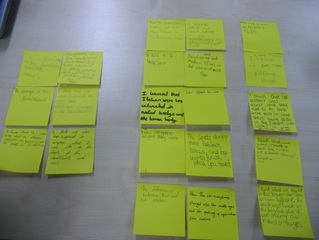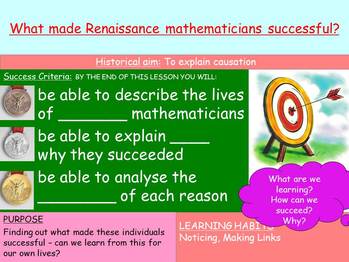How can we share learning intentions with students effectively?
In Part I, I argued that sharing learning intentions with students was important and concluded that the acid test of success in doing this lay in students’ correctly answering the question:
“What do you think you were supposed to learn from the lesson?”
I had increasingly been questioning the effectiveness of my own practice and so I tested this by asking my own classes.
 On the right is an example from a lesson in which I intended students to understand the most important changes which took place during the Renaissance (click on the picture to expand).
On the right is an example from a lesson in which I intended students to understand the most important changes which took place during the Renaissance (click on the picture to expand).
On the left, six students summarised the aims as I might have done myself, for example: ‘I think that this lesson was about the differences between the beginning and the end of the Renaissance.’
In the middle, ten students made statements which hinted at understanding of the lesson, but either demonstrated misconceptions or had not fully appreciated the true purpose in my mind: ‘The development between times and trying to finish what you started,’ ‘I learned that the Italians were so interested in naked bodies and the human body.’
On the right, five students made statements which gave me no confidence they understood the meaning of the lesson and might have been about almost anything: ‘I think to explain different things.’The other two classes revealed fairly similar results – I clearly needed to make improvements.
This post examines some of the ways which I have seen advocated to share learning intentions and considers how effective they are. In Part III, I discuss what I actually did and evaluate how well it worked.
(This focuses on objectives for lessons; I have written about clarifying learning intentions regarding the product of these lessons here).
What had I been doing?
 The key feature of the last four years had been getting my students to guess the missing words on a slide like the one on the left – using ‘lollipop sticks.’ Sometimes I used this as a chance to discuss key terms, link this lesson with others or explore the ‘why’ of what we were doing.
The key feature of the last four years had been getting my students to guess the missing words on a slide like the one on the left – using ‘lollipop sticks.’ Sometimes I used this as a chance to discuss key terms, link this lesson with others or explore the ‘why’ of what we were doing.
I had tinkered with this a lot: I changed must/should/could to bronze/silver/gold, inspired by something I read from Sally Thorne in a discussion forum. I added ‘purpose’ a year in and ‘learning habits’ influenced by Building Learning Power. Most recently, I included a ‘historical aim.’
The idea was that by getting students to guess the missing words, they had to actually read them and think about them. An obvious limitation was that only one student was responding at any one time- and while I thought it implicit that all students should be guessing, since any of them might be called upon, there was a question as to whether this was happening or how effective the process was at all.
I wanted to find something which:
a) was a better use of time (getting more students to do more thinking at once)
b) was more open to student ‘ownership’
c) engendered deeper student understanding of what we were doing and why – and was more useful throughout the lesson
How should learning intentions be formulated?
I’ve spent a while trying to understand this and as far as I understand it, Dylan Wiliam’s solution to this is to divide learning intentions into three strands;
Learning Intention – what all students should be improving in
Learning Context – where the practice they will be doing will be situated
Success Criteria – the different ways in which students will respond (and the progression route for them).
For example, for the lesson for which I evaluated students understanding of learning intentions was investigating why the Renaissance is significant – and would have broken down thus:
Learning Intention: understanding significance
Learning Context: the Renaissance
Success Criteria: describe changes/explain their results/identify their impact/analyse how significant this was.
Dylan Wiliam argues: “We are not interested in our students’ ability to do what we have taught them to do. We are only interested in their ability to apply their newly acquired knowledge to a similar but different context (2011, p.60).” He offers the example of maths: once students can do 1/2 + 3/5, we’re only really interested in whether they can apply this to other factions. In his terms, the learning intention is adding (or manipulating) fractions, the context is those examples. Similarly, he notes that we don’t want students to be able to punctuate the text we gave them, we want them to be able to punctuate texts in general.I’ve wrestled with this for a long time and I don’t think it really works – at least in history. For the lesson example given above, I have shown this division: students are learning to evaluate significance better, in the context of the Renaissance. I certainly hope that they will apply this conceptual understanding when we study the Industrial Revolution- remembering our criteria for significance, how we prove significance and look for similar strands in other time periods. The problem comes with moving on from the context of learning: provided students remember how to add fractions, memory of individual pairs is unnecessary (although not unhelpful). However, in history, I want students to retain their knowledge of the learning context, the Renaissance. Right now, they are studying the history of maths – but an understanding of the Renaissance will remain important when they seek to understand the Reformation or the birth of European empires. Moreover, to appreciate what makes the Renaissance significant, they will have to understand what made the Middle Ages significant. I don’t believe in decontextualised tasks in history – perhaps all maths questions are novel; the same does not apply to historical questions.
So having played around with this angle of how I formulate learning intentions and been left unsatisfied, I concluded that I had to think about how I delivered them to students instead.
How might I have improved what I was doing?
I spent time collecting ideas about how teachers help students to understand learning intentions and have grouped ideas below, by what I think is the underlying aim of each one. The numbers afterwards refer to my responses to each strategy, below.
Understanding of learning intentions, students:
– Rewrite the learning objectives in their own words; compare suggestions (1)
– Annotate the key words/phrases in learning intentions (2)
Control over learning intentions, students:
– Suggest the learning objective for the lesson (3)
– Choose which learning objective they feel is the main priority. (3)
– Suggest what next lesson’s learning objectives should be. (3)
Responsibility for tracking progress towards learning intentions, teachers:
– Distribute a range of learning objectives to students; at the end of the lesson students discuss who has the correct learning objective and how they know (4)
– Add an extra learning objective; ask students to identify which one has not been covered and how they know (4).
– Incorporate a mini plenary where students evaluate their progress towards the objectives part way through the lesson.
However, I felt that those numbered:
1) Looked like it would ensure understanding but could be exceptionally time-consuming
2) Didn’t go much beyond what I was doing already
3) Opened up the direction of the lesson far more than was likely to help me ensure students attained successful long term-goals. (I might ask them to suggest possible questions from an initial stimulus, for example, but only if this was likely to be particular helpful in developing their thinking towards the line of enquiry I had already chosen).
4) Didn’t seem likely to ensure students were clear about the direction of the lesson while learning was taking place – thus failing to meet the requirement of ensuring student understanding and removing ambiguity.
None of these looked like they would work – although I’d be interested to hear from teachers who have used similar strategies. In Part III, I explain the approach I took and consider how well it worked.
[Originally posted, July 2013]
